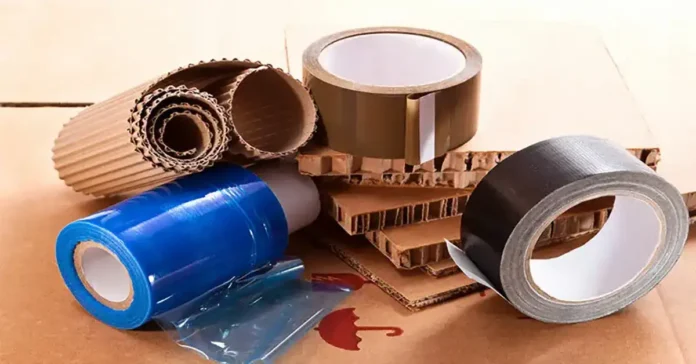Moving can be a daunting task, but with the right packing materials and techniques, it becomes much easier. Whether you’re relocating to a new home or simply need to store your belongings temporarily, choosing the best packing materials is important for ensuring the safety and security of your items. From sturdy boxes and bubble wrap to packing peanuts and furniture covers, we’ll explore a wide range of packing materials to suit various needs and preferences.
Our goal is to empower you with the knowledge and tools to pack efficiently, protect your belongings from damage, and optimize storage space. With this comprehensive guide, you will go through everything you need to know about selecting, using, and maximizing packing materials for both moving and self-storage purposes. Let’s get packing!
Choose Perfect Packing Materials
Selecting the perfect packing materials is the cornerstone of a successful move or self-storage endeavor. Begin by assessing the nature of your belongings – fragile items require cushioning materials like bubble wrap or packing paper, while sturdy items may thrive in durable boxes. Choose high-quality moving boxes that can withstand the weight and protect your possessions. Seal the deal with sturdy packing tape to ensure the integrity of your carefully packed boxes.
Additionally, consider investing in furniture covers and mattress bags to shield larger items from dust and scratches. Don’t forget labeling supplies for an organized unpacking process. Tailoring your packing materials to the specific needs of your items ensures they arrive at their destination unscathed, turning the sometimes daunting task of moving into a well-organized and secure adventure.
4 Steps to Consider While Packing for Storage or Relocation
- First make a list of everything that needs packing.
- Next, weigh them to get packaging material that is strong enough to hold the goods.
- Procure packing material suitable to the size, weight, and nature of the goods. Do not skimp on quality. Improper packing can lead to damage to your goods, incurring a heavy loss.
- Find a self-storage facility that gives you adequate space for goods that need to go into storage. Ensure the facility is easily accessible and gives your possessions absolute protection.
Moving house is an exciting time, but it can also be stressful if you have not planned. Do not leave everything to the movers and packers. We have put together a guide to help you plan your move and get everything packed efficiently and safely.
4 Essential Packing Cases and Boxes
When choosing packing cases or boxes you need to make sure that they fit the size of the objects inside them. Purchase boxes that are strong and sturdy – a flimsy box from a supermarket will split easily. A professional company that specializes in storage or removals will supply a range of differently shaped corrugated cardboard boxes specifically designed to be strong enough to hold heavy loads. Place large or heavier items at the base of boxes and pack small, light, or more flexible items on the top or in the gaps in the boxes to keep the base strong.
These boxes are available in a variety of materials like cardboard, paperboard, plastic, and wood. You can choose the material depending on your needs. For example, if you need to ship an item quickly, then you could opt for a cheaper option like cardboard. If you need to protect your item from damage during shipping, then you should go for a stronger material like wood.
There are various kinds of packing boxes that will help you when packing up your products for shipping or storage.
- Small Cardboard Boxes / Medium Cardboard Boxes
Cardboard boxes are a key player in transporting your belongings around the world. Not only that but they can also be flattened down to a compact size on arrival at your destination and then reused repeatedly.
Small cardboard boxes are perfect for CDs, small decorative ornaments, stationery, and other small random objects lying around the house. You can also put away your essentials like phone chargers, keys, and anything else you might need when moving in a small box to keep with you. The smallest boxes are best for small items like jewellery, personal care products, stationery, and other small items.
A medium box is best suited for storing larger items like photo albums, books, kitchen utensils, small appliances, computers, and footwear. Keep in the mind the capacity of the box and refrain from overloading it. Cramming boxes beyond the recommended capacity makes it difficult to move them around. They could also split open during transit.
- Large Cardboard and Plastic Boxes
Large Boxes are great for storing various things. You can store all sorts of items in them, including clothing, bedding, lamps, kitchenware, toys, and other small items. Do not fill them too full because you will struggle with lifting them and/ or moving them around.
Choose the largest size of cardboard container for those light, yet bulky items that take up a lot of space. These include curtains, tapestry, linen, bedding, and pillows, among others. They can hold sizeable items like mattresses, couches, tables, chairs, and even full-size beds. Premium boxes sometimes have wheels to help you move bulky and heavy items around easily.
- Specialty Boxes
For items like mirrors, wardrobes and pictures, a standard cardboard box will not cut it. These items require specialized packaging, which is why you should opt for custom-made boxes. You must also purchase packing materials, such as bubble wrap and corrugated board, to ensure the safety of your item through transit and while in storage.
You should pack your structured clothing carefully when moving house. If you put your expensive clothes like tuxedos, special gowns, sherwanis, and lehengas in a regular cardboard box, they may get crushed during transit. Make sure you buy specially design wardrobe boxes, to hold such clothes while transporting them. These boxes are also useful if you have seasonal clothing that needs to be stored during off-season. You can keep your winter gear in the box during the summer months and vice versa. Wardrobe boxes come in many sizes and styles – choose them according to your requirement.
- Document Boxes
Be sure to buy a suitable number of document boxes to carefully put away important files and documents. Label and seal the boxes yourself, rather than leaving them to the movers and packers. If these boxes are going into a self-storage unit, make a handy list of what each box contains for future reference. Avoid putting legal documents and bank documents in a storage unit.
11 Wrapping and Packing Materials for Storage and Moving
If you just pack everything up and send it off to storage, you may end up with broken items when you unpack them. You need to protect your possessions properly before sending them off. Wrapping and packing supplies are available at any local store. Here are 11 examples of the various kinds of wrapping and packing material you can choose from:
- Bubble Wrap
Bubble wrap is great for protecting fragile items like jewellery, electronics, and other small items. It is also useful for keeping bulky items together while shipping them. Bubble wrap is made from polystyrene foam, which is very lightweight and easy to pack.
- Strong Tape
Everyday Sellotape is not suitable for sealing boxes at the time of packing and moving. You need to invest in stronger, wider tape for packing which will help keep your goods safe and secure. You should also buy high-quality tape because it will last longer and ensure that your items stay protected.
- Permanent Markers and Labels
When moving, it is important to remember that boxes often get mixed together during transport. If you are sure what room each box should go in, mark them clearly with a permanent marker so they will not rub off. You can also label each box with its contents if you know what those are. Labels are another option, but they need to be secured properly to ensure they do not fall off during transportation.
- Packing Paper
Line the cardboard boxes with packing paper to create soft cushioning for your books, magazines, and other items. You could wrap packing paper around breakable items or cover the contents of a box. This just adds another layer of protection, which helps prevent damage to your items. Packing paper will not leave any marks on your belongings and protects them from knocks and bumps.
- Cling Film
Cling Film is a great tool for protecting your clothes from getting dirty or wrinkled. It is also useful when you need to cover something that needs to stay dry, like a piece of art or an expensive item. You can even use it to protect delicate items like jewellery or electronics.
- Speciality Plastic Covers
Go with specialty plastic covers for a waterproof covering for your large furniture items and appliances. Not only does this covering keep water out, but it will also protect your furniture from dust, chemicals, and other debris. These covers are usually transparent, making it easy to see what the package contains.
There is a large assortment of plastic bags available for storing items. They are specifically made for storing chairs, couches, or beds. These bags are exceptionally durable and will last longer than regular plastic bags. Go for specialized mattress covers to protect your mattress when stored or transported.
- Speciality Moving Blankets
If you need to pack light, consider using blankets instead of plastic covers, but remember regular blankets are not waterproof. You can buy moving blankets made specifically for packing, or you can use ones you already own. A moving blanket is an item that you can put your furniture inside when you move house. Moving blankets come in assorted sizes, shapes, and materials. They are made from cotton, polyester, or nylon. You can choose a moving blanket that is suitable for your needs, whether you are moving across town or the country. These blankets should be washed and dried like any other blanket before use.
- Stretch Wrap
If you are looking to store your furniture for a bit, stretch wrap is an effortless way to keep it protected. Stretch wrap is a flexible plastic sheet that comes in varied sizes and shapes. It can be used to cover items like couches, chairs, tables, beds, and even walls. You can also use it to protect other materials like wood, metal, glass, and paper.
- Tarp
You can use tarps to protect an item that does not fit into a box. Tarps are made of durable polyester material and come in a wide variety of sizes.
- Straps
Straps made of polyester or nylon are often used to secure boxes. The main advantage of straps is that in addition to tying down the boxes, they are extremely useful when you must move the boxes by providing good grip. Good grip can help ensure that the boxes do not move around haphazardly or fall.
- Poly Rope
Poly rope is durable and resistant to moisture, sunlight, heat, and other damaging forces. It is also great for tying objects down to a vehicle or truck during a moving day. Poly rope comes in a variety of assorted sizes and colours, making it easy to choose the right size for any job.
Final Words
Now, with the knowledge gained from this guide, you’re well-prepared for a successful relocation or storage endeavor. Remember, selecting the right packing materials is essential for protecting your belongings. Whether you’re moving to a new home or utilizing self-storage, the proper use of packing materials can make all the difference. From sturdy boxes to bubble wrap and packing tape, each material is safeguarding your items during transit or storage.
By following the tips outlined in this guide, you can pack efficiently, minimize risks of damage, and feel relaxed throughout the moving or storage process. Relocation is always a suitable time to declutter. Assess your possessions. Decide what you need to take with you and what goes into storage. Make sure you have enough time to pack all your items properly and securely. Do not forget to label each box with its contents and keep track of everything.
FAQs
Q1: What are essential packing materials for moving and self-storage?
A: They include sturdy boxes, bubble wrap, packing tape, and furniture covers to ensure your belongings stay secure during the move or storage.
A: Choose boxes of various sizes to accommodate different items. Use durable corrugated boxes for heavier items and smaller boxes for fragile belongings.
A: Yes, you can reuse them but make sure they are clean, reinforced with additional tape if needed, and suitable for the items you’re packing.
A: Use small bubble wrap for delicate items like glassware and large bubble wrap for larger, less fragile items.
A: Plan on using approximately 8-10 rolls of packing tape for an average-sized home. Invest in high-quality tape to securely seal boxes and prevent breakage.
A: Yes, choose biodegradable packing materials like eco-friendly bubble wrap, cardboard boxes, and paper packing tape for a more sustainable move.
A: Use furniture covers, blankets, or moving pads to shield furniture from scratches and dings. Secure covers in place with packing tape or furniture straps.
A: Yes, labeling boxes with their contents and the room they belong to makes unpacking much easier. Consider color-coding for quick identification.
A: Yes, use alternatives like packing paper, clothing, or towels to cushion fragile items. Ensure they are well-padded to minimize the risk of breakage.
A: You can use silica gel packets in boxes, use plastic wrap or bags for extra protection, and consider climate-controlled storage for added security against humidity.







